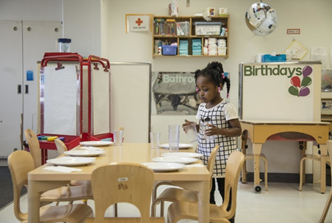5.1 Creating an Environment for Social and Emotional Learning
Teachers in a high-quality preschool program ensure that all the children feel safe and nurtured. They know how to create a classroom climate of cooperation, mutual respect, and tolerance and support children in developing skills needed to solve problems and resolve conflicts with peers. Social and emotional learning is central to young children’s development in the preschool years and works hand in hand with cognitive and academic learning. To learn well, they need to feel safe, to feel comfortable with their preschool teacher, and to be supported in their play with other children. All these factors interact with each other and either promote or detract from children’s learning and well-being. Because preschool children are naturally curious and learn best in meaningful contexts, teachers responsible for planning the learning environment and curriculum will best support children’s learning and development when they use a variety of strategies to support children’s learning—such as focusing on interactions, scaffolding learning experiences, engaging in explicit instruction, changing the environment and materials, and making adaptations to the learning environment.
Teachers make use of daily routines as an important context for learning, integrating engaging learning opportunities into the everyday routines of arrivals, departures, mealtimes, naptimes, hand- washing, setup, and cleanup, both indoors and outdoors. Children enthusiastically practice and apply emerging skills when they are helpers who ring the bell to signal it is time to come inside; when they count how many are ready for lunch; when they move a card with a child’s photo and name from the “home” column to the “preschool” column of a chart near the room entry; when they put their name on a waiting list to paint at the easel; or when they help set the table for a meal, making sure that each place has a plate, utensils, and a cup. Such routines offer opportunities for children to build language skills, to learn the rituals of sharing time with others, and to relate one action in a sequence to another” (adapted from CDE 2010, 18).

Based on teachers’ assessments of individual children’s learning, the teachers might add materials to play-based interest areas, decide to read books with small or large groups, adapt activities to meet the diverse learning needs of children in the classroom, and think of a particular topic area that children would be interested in investigating. Guided by the California preschool learning foundations, teachers use their understanding of children’s learning and development as a way to ensure they adequately support children’s development across all domains. With clear ideas or objectives in mind, teachers plan curriculum that includes strategies to enhance the learning of all children in a group, as well as strategies to support the learning of individual children (adapted from CDE 2010a, 21). Please refer to Chapter 4 for a closer look at the curriculum planning process.[1]
- California Preschool Program Guidelines by the California Department of Education is used with permission (pg. 40-45) ↵

